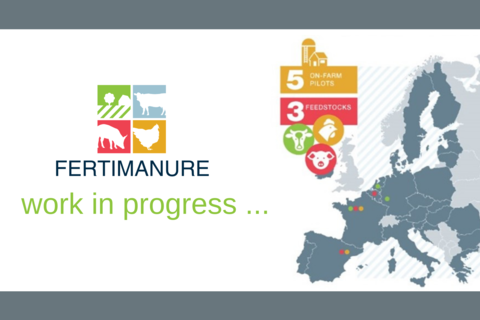Advancement of on-farm experimental pilots

FERTIMANURE has already started to implement and run the on-farm pilots set up in Spain, The Netherlands, Belgium, Germany, and France.
Spain
In Spain, a pilot-scale biorefinery, managed by Cooperativa Plana de Vic, was installed at a pig farm in Catalonia. The three entities responsible for the design, implementation and performance of the Spanish pilot are UVIC, LEITAT and AlgaEnergy. The biorefinery installation makes use of different technologies to valorise pig slurry: a separation unit, a biodrying process coupled to a biomass boiler, a membrane-based system (consisting of a membrane contactor, microfiltration unit and a reverse osmosis), a freeze concentrator, and an algae-based cultivation reactor coupled to an enzymatic hydrolysis unit. The biorefinery has a valorising capacity of 3m3/day of raw pig slurry and is expected to be running for two years. Several value-added products will also be manufactured at the biorefinery, such as a biofuel, a soil amendment, a nutrient-rich liquid fertiliser, ammonium salts and biostimulants, ensuring that fertilising needs in nutrient deficient areas are met.
The Netherlands
The Dutch nutrient recovery pilot plant has been engineered by the Arjan Prinsen Farm and Dorset Green Machines in collaboration with Wageningen Environmental Research for monitoring purposes. It is operational and is situated in the ‘Achterhoek’ region of the Netherlands. The plant currently produces the following fertilising products: a soil conditioner, an organic phosphorus (P)- rich fertiliser, an ammonium sulphate solution, and a liquid potassium (K) fertiliser. In 2020 the ammonia stripper was optimised by adding two spray nozzles to improve the transfer of dissolved ammonia to the gas phase. There are plans to add an additional heat exchanger to the stripper, allowing it to operate at a higher temperature to speed up the stripping. The pH of the produced ammonium sulphate solution can be increased to the desired value for application by continuation of ammonia scrubbing after stopping the dosage of sulphuric acid. Remaining acid as such gets neutralised by the absorbed ammonia. This makes the ammonia sulphate solution a versatile product. The biological acidification tank achieves a lower pH than the digester. It is however desirable, to optimise the feedstock of the biological acidification tank, to lower its pH further as the optimal pH range for the hydrolysis step of anaerobic digestion is 5–7. Early in 2021 the installed flowmeters will become operational to monitor the quantities of nutrient flows. Additionally, it will be investigated if adding a magnesium (Mg) or calcium (Ca) base to the settling tank can remove more particles from the influent of the stripper and/or increase the P content of the organic P-rich fertiliser. Adding an Mg or Ca base results in the formation of calcium phosphate or magnesium ammonium phosphate (struvite). Tests will be done to dry the produced organic phosphorus (P)-rich fertiliser in an efficient way. Finally, it will be investigated if an ammonium nitrate solution can be safely produced with the current configuration of the ammonia scrubber and/or if there are other alternatives.
Belgium
The Belgian stripping-scrubbing pilot unit has been installed at the IVACO pig husbandry farm in Gistel-Zevekote in West-Flanders and is currently monitored by Ghent University. The ammonia (NH3) stripping-scrubbing technology is used to recover mineral nitrogen from the liquid fraction (LF) of digestate and pig manure as ammonium nitrate which could be used as a replacement for mineral nitrogen (N) fertilisers. Currently, the pilot has a capacity of 15,000–20,000 tonnes of LF of digestate per year. In 2020, an NH3 recovery of 32% was recorded without heating the digestate and with a retention time of between 1 and 3 hours. There are plans to optimise stripping efficiency by analysing the impact of the temperature and retention time during a test campaign in early 2021. Additionally, regular monitoring will be continued to obtain insights into the variability and quality of the scrubbing salts. These results will be key to developing a market analysis for the scrubber systems and their produced ammonium salts.
Germany
The activities of the German pilot plant installed at the facilities of Fraunhofer UMSICHT in Sulzbach-Rosenberg are running successfully. The pre-treatment of cattle dung including additive mixing, drying, chopping and pelletising is going on and the first charge of 2 tonnes of pellet feedstock is programmed to be ready in January 2021. The Thermo-Catalytic Reforming plant with a capacity of 30 kg/hour input has been tested with a new control system, which allows for the remote monitoring and operation of the plant. The Mono-Ammonium-Phosphate (MAP)-reactor is at design stage and the ordering process for materials and instruments, as well as the construction in the workshop at the facilities of Fraunhofer UMSICHT, are due to start shortly. The commissioning of the MAP-reactor including technical and safety documentation is foreseen for the first quarter of 2021, and will be followed by the start of the fully operation of the continuous integrated pilot plant. This plant will deliver valuable biobased fertilisers and soil amendments such as phosphorus-rich biochar and ammonium phosphate, as well as energy carriers like bio-oil and syngas.
France
In France, nitrogen (N) stripping and pyrolysis pilots will be run on farms. To begin with, pilots will start to operate in Brittany (at the Kerguéhennec experimental station) in January 2021. In a second step, pilots will move from farm to farm, in the northern half of France, to test other types of manure. The French Chambers of Agriculture (APCA, CRA Brittany, CRA Grand Est, and CA Somme) and RITTMO Agroenvironnement ® are the entities responsible for the design, implementation, and performance of the French pilots. Pyrolysis (heat treatment without oxygen) will transform poultry manure into biochar, a soil amendment. The valorisation capacity is 90kg raw manure/day. The N-stripper, with a capacity of 150 L/day, will transform the liquid fraction of manure into nutrient-rich liquid fertiliser: ammonium salts and K-rich fraction. These products will be used as substitutes for conventional fertilisers in upcoming field trials (Grand Est, Brittany, and Somme).